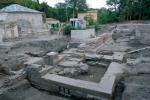Summary (English)
AQUAE CALIDAE – THERMA (TsonyaDrazheva, DimchoMomchilov – karnobat.muzey@mail.bg) The baths were 76 m long in direction north – south, while 32 m of their length in direction east – west was discovered so far. The tepidarium in the southern sector of the baths, 9 m by 9.80 m in size, was explored. Its walls were built of ashlars, 1 – 2.60 m long, bonded with mortar. The floor was paved with slabs. The tepidarium had three entrances, 1.15 – 1.20 m wide: eastern, western and northern, which was walled in a later period. The foundations of the prefurnium were documented in front of the southwestern side of the tepidarium. This part of the baths was built in the beginning of the 2nd century AD. A hoard was discovered at the foundations of the western outer wall of the tepidarium, consisting of seven gold Byzantine coins: one of Constantine IV Pogonatos and six of Justinian II Rhinotmetos. The deposit of the hoard could be related to the Battle at Anchialos in AD 708 when the Byzantine army of Justinian II Rhinotmetos was defeated by the army of the proto-Bulgarian Khan Tervel (AD 700 – 721). The explorations continued in the eastern sector of the baths, in the vestibulum balnearum, 43.50 m long and 16 m wide, which was divided in two parts during the 11th century. During a Gothic invasion in the second half of the 3rd century AD, the vestibulum balnearum was burned and its roof collapsed over the terracotta water-conduit of the 2nd century AD. At the end of the 4th century AD a new wall in opus mixtum was built along the western side of the eastern sector. During the end of the 5th – 6th century AD the wall was reconstructed and stone pilasters were built, located at 2 – 2.50 m from each other. Nine burials were discovered in the eastern part of the vestibulum balnearum, dug out into a layer of the 2nd – middle of the 4th century AD with traces from fire. The deceased were oriented east – west and the grave goods comprised terracotta lamps, jewelry and coins of Constantine the Great, Constantine II and Constans. A hall, 10 m by 12.50 m in size, was discovered in the northern sector of the baths. An anteroom paved with slabs was located from the northern side of the baths. Coins, 17 lead seals, pottery and jewelry were found, dating the reconstruction of the northern part of the baths to the 11th – beginning of the 12th century.
- Tsonya Drazheva - Regional Museum – Burgas
- Dimcho Momchilov - Museum of History – Karnobat
Director
Team
Research Body
- Regional Museum – Burgas






![Download [PDF]](/excavation/skins/fasti/images/results/download_sml.png)

